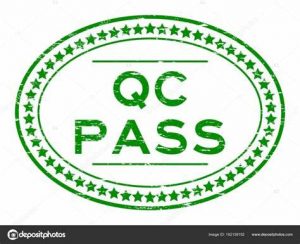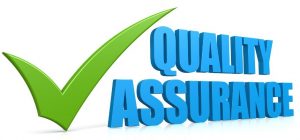Simply speaking, QA controls the process, QC controls the product

QC: Quality Control, quality control, product quality inspection, analysis, improvement and quality control of related personnel after finding quality problems. Generally includes IQC (Incoming Quality Control: incoming inspection), IPQC (In-Process Quality Control: process inspection), FQC (Final Quality Control: finished product inspection), OQC (Out-going Quality Control: shipping inspection). QC focuses on products, not systems (systems). This is the main difference between QC and QA. The purpose is the same as QA. They both “meet or exceed customer requirements.”

QA: Quality Assurance, quality assurance, to ensure that there is no problem with product quality by establishing and maintaining a quality management system. Generally includes system engineer, SQE (Supplier Quality Engineer: supplier quality engineer), CTS (customer technical service staff), 6sigma engineer, calibration and management of measuring instruments and other personnel. QA not only needs to know where the problems are, but also how to formulate solutions to these problems, and how to prevent them in the future. QC needs to know that if there is a problem, it should be controlled, but it does not have to know why it should be controlled in this way.
To sum up, QC: Mainly after-the-fact quality inspection activities, default errors are allowed, and it is expected to find and select errors. QA is mainly quality assurance activities in advance, focusing on prevention, and expects to reduce the chance of errors.
QC is the operating technology and activities adopted to make the product meet the quality requirements. It includes inspection, correction and feedback. For example, QC will remove the defective products after inspection, and then feedback the defective information to relevant departments to take improvement measures. Therefore, the scope of QC’s control is mainly within the factory. Its purpose is to prevent non-conforming products from being put in, reordered, and shipped out, to ensure that products meet quality requirements and only qualified products can be delivered to customers.
QA is to provide trust to meet customer requirements, even if the customer is convinced that the product you provide can meet his requirements, so you need to start from market research and review customer requirements, product development, order and material procurement, incoming inspection, production process Control, shipment, and after-sales service leave evidence at each stage, confirming that every step of the factory’s activities is carried out according to customer requirements.
The purpose of QA is not to ensure product quality. It is the task of QC to ensure product quality. QA is mainly to provide conviction, so it is necessary to manage the entire process of understanding customer requirements from the beginning to the after-sales service. This requires companies to establish a quality control system, formulate corresponding documents to standardize the activities of each process, and leave evidence of the implementation of activities in order to provide trust. This trust can be divided into two types: internal and external. Even if the customer is assured, they believe that the factory produces and delivers products according to their requirements. Internally, they are assured that the owner of the factory is responsible because the owner is the first person responsible for product quality. He has to take full responsibility, which is also the main requirement for countries to formulate product quality laws to promote enterprises to really attach importance to quality. Therefore, in order to avoid quality responsibility, the boss must standardize activities and leave evidence. But if the factory personnel operate according to the document requirements, the boss cannot understand them one by one. This requires QA to perform audits on his behalf to understand whether the document requirements have been complied with, so as to convince the boss that the activities of the plant are carried out in accordance with the documents. Reassure him. Therefore, the main difference between QC and QA is that the former is to ensure that the product quality meets the requirements, and the latter is to establish a system and ensure that the system operates as required to provide internal and external trust. At the same time, QC and QA have the same points: that is, QC and QA must be verified. For example, QC testing products according to standards is to verify that the products meet the requirements, and QA internal audit is to verify whether the system operation meets the standard requirements. Cargo audit and reliability testing is to verify whether the product has performed various activities in accordance with the regulations and whether it can meet the requirements to ensure that the products delivered by the factory are qualified and meet the relevant regulations.